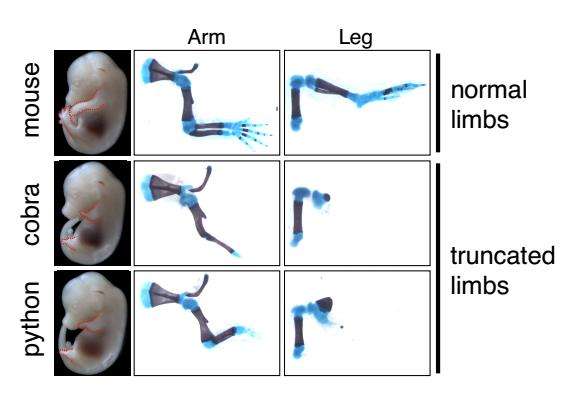How snakes lost a blueprint for making limbs

Snakes lost their limbs over 100 million years ago, but scientists have struggled to identify the genetic changes involved. A Cell paper publishing October 20 sheds some light on the process, describing a stretch of DNA involved in limb formation that is mutated in snakes. When researchers inserted the snake DNA into mice, the animals developed truncated limbs, suggesting that a critical stretch of DNA lost its ability to support limb growth during snake evolution.
"This is one of many components of the DNA instructions needed for making limbs in humans and, essentially, all other legged vertebrates. In snakes, it's broken," says Axel Visel, a geneticist at the Lawrence Berkeley National Laboratory and senior author on the paper. "It's probably one of several evolutionary steps that occurred in snakes, which, unlike most mammals and reptiles, can no longer form limbs."
Today's serpents have undergone one of the most dramatic body plan changes in the evolution of vertebrates. To study the molecular roots of this adaptation, Visel and his colleagues started looking at published snake genomes, including the genomes from basal snakes such as boa and python, which have vestigial legs—tiny leg bones buried in their muscles— and advanced snakes, such as viper and cobra, which that have lost all limb structures. Within these genomes, they focused specifically on a gene called Sonic hedgehog, or Shh, involved in many developmental processes—including limb formation. The researchers delved further into one of the Shh gene regulators, a stretch of DNA called ZRS (the Zone of Polarizing Activity Regulatory Sequence) that was present but had diverged in snakes.
To determine the consequences of these mutations, the researchers used CRISPR, a genome-editing method, to insert the ZRS from various other vertebrates into mice, replacing the mouse regulator. With the ZRS of other mammals, such as humans, the mice developed normal limbs. Even when they inserted the ZRS from fish, whose fins are structurally very different from limbs, the mice developed normal limbs. However, when the researchers replaced the mouse ZRS with the python or cobra version, the mice went on to develop severely truncated forelimbs and hindlimbs.
"Using these new genomic tools, we can begin to explore how different evolutionary versions of the same enhancer affect limb development and actually see what happens," says Visel. "We used to be mostly staring at sequences and speculating about molecular evolution, but now, we can really take these studies to the next level."
To identify the mutations in the snakes' ZRS that were responsible for its inactivation during snake evolution, the researchers took a closer look at the evolutionary history of individual sequence changes. By comparing the genomes of snakes and other vertebrates, they identified one particularly suspicious 17 base-pair deletion that only occurred in snakes; this deletion removed a stretch of the ZRS that has a key role in regulating the Shh gene in legged animals.
The research team turned back the evolutionary clock, restoring the missing 17 base pairs in an artificially created hybrid version of the python ZRS, and tested the edited DNA in mice. Those that carried this evolutionarily "resurrected" ZRS in their genome, replacing their normal regulator, developed normal legs. However, Visel cautions that the evolutionary events were probably more complex than just the one deletion: "There's likely some redundancy built into in the mouse ZRS. A few of the other mutations in the snake ZRS probably also played a role in its loss of function during evolution."
Of course, snakes aren't the only vertebrate animals that lack arms and legs—some lizards, eels and other fish, and marine mammals, for example, have also adapted limb reduction to varying degrees and likely underwent a slightly different evolutionary process. "Loss of limbs has occurred multiple times independently during animal evolution, and it's safe to assume that mutations affecting other genes were involved," says Visel. "It's a complex problem, but with the introduction of genome-editing tools, we can finally start tying specific DNA changes to alterations in body shape more systematically."
More information: Cell, Kvon et al.: "Progressive Loss of Function in a Limb Enhancer During Snake Evolution" www.cell.com/cell/fulltext/S0092-8674(16)31310-1 , DOI: 10.1016/j.cell.2016.09.028
Journal information: Cell
Provided by Cell Press



















